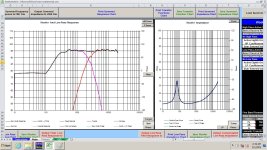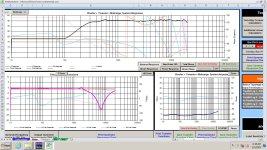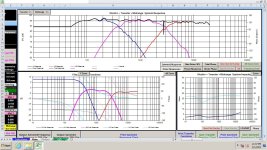We would be a lot more help to you if you showed the filtered measurements like I suggested in post # 712.Post 708 has the file for mid and tw. I was focusing on just these two drivers. Flattened each individually, then xo and then tried to time align using delays. The measurements titles show delays I tried.
Without that information, we are left to guess at what you are doing.
Here's a sim inspired suggestion. Might not work, but sure looked good in the sim. It's simple. Change the mid filter to 4th order Butterworth at 2.1K. Leave the tweeter at 2.5k LR4. Maybe in a week, we will see. Till then, you could listen to it, and guess about how well it will measure.
Here are the driver measurements from the 3rd and 4th sessions:
- the 3rd one has raw tweeter and woofers, including off axis (the mid measurement I have messed up). Large room (church). Mic distance 1m, distance to floor 2m+
- the 4th is tw and mid, on axis only, raw and then eq-ed a bit and bfc on mid. there is also LR4 applied. At home, distance to floor/ceiling abt 1.2-1.1m depending on driver. mic distance 60cm.
Attachments
I came up with some interesting results. Still playing, but here's what I see.
Your tweeter response looks perfect. I made changes to the mid response. It looked pretty good, but the tweeter was perfect, so worked with the mid.
What I did was this. I made an frd of your filtered mid, and tweeter responses.
Then I loaded those filtered responses into my PCD sim software. They added nice, but didn't have a remarkable reverse null..
I noticed that you did not notch the mid peak near 7k, so I added that EQ in the software. I notched it 20dB. The Q is 1. The resulting mid roll-off became 30dB per octave, and the reverse null looked great.
AllenB will fuss about looking at that, so I also looked at the phase. As I added the notch at 7k, they lined up better. Much better. There is no delay on either driver.
So, assuming the phase in the data is accurate, adding a notch at 7k seems to improve things. I also added a touch of EQ at 1.7k. 2dB with a Q of 3.
Note that I did not change the settings for measurement distance in PCD. That could have an effect since you measured close, and midway between drivers. I can look into that later.
On the phase graph, the blue woofer phase still shows. I tried to remove it for clarity, but could not for some reason.
Your tweeter response looks perfect. I made changes to the mid response. It looked pretty good, but the tweeter was perfect, so worked with the mid.
What I did was this. I made an frd of your filtered mid, and tweeter responses.
Then I loaded those filtered responses into my PCD sim software. They added nice, but didn't have a remarkable reverse null..
I noticed that you did not notch the mid peak near 7k, so I added that EQ in the software. I notched it 20dB. The Q is 1. The resulting mid roll-off became 30dB per octave, and the reverse null looked great.
AllenB will fuss about looking at that, so I also looked at the phase. As I added the notch at 7k, they lined up better. Much better. There is no delay on either driver.
So, assuming the phase in the data is accurate, adding a notch at 7k seems to improve things. I also added a touch of EQ at 1.7k. 2dB with a Q of 3.
Note that I did not change the settings for measurement distance in PCD. That could have an effect since you measured close, and midway between drivers. I can look into that later.
On the phase graph, the blue woofer phase still shows. I tried to remove it for clarity, but could not for some reason.
Attachments
Last edited:
Well, that was my finding - no delays at the best null.
The tweeter is recessed into the waveguide by about 12mm (baffle plane to dome top), maybe that provides the luckily matching delay.
I also liked the tweeter response - almost perfectly flat. With the tapering bevels I think directivity and diffraction are very decent, too.
The mid: some of the deviation is definitely the baffle diffraction ripple and the baffle step drop. Not sure if there are any other faults to find and correct. I will try your eq to see how it works.
I also need to integrate the woofers.
Thank you for studying this!
The tweeter is recessed into the waveguide by about 12mm (baffle plane to dome top), maybe that provides the luckily matching delay.
I also liked the tweeter response - almost perfectly flat. With the tapering bevels I think directivity and diffraction are very decent, too.
The mid: some of the deviation is definitely the baffle diffraction ripple and the baffle step drop. Not sure if there are any other faults to find and correct. I will try your eq to see how it works.
I also need to integrate the woofers.
Thank you for studying this!
I have not even thought about 7k on the mid as it is more than an octave above xo. I thought LR4 will push it low enough not to matter. Or even LR8. But I think I heard some people advise to clean the drivers to two octaves out of the xo. Is this the reasoning for what you are doing at 7k? Or is there another specific reason?
I would also have never thought of a 20dB notch. How did you decide on that depth?
I would also have never thought of a 20dB notch. How did you decide on that depth?
Breakup is never good to hear, even if it's down a ways. Initially, I notched it about 6dB just to make the roll-off better. Then I played with delays, and didn't find much improvement. So then I started looking at the phase. It didn't seem to change much with different delays. Then I played with the amount of EQ for the notch. The more I added, the better the phase matched. I figured the software would stop at -12dB, but it kept going. Next I looked at how steep the roll-off became. Basically 5th order. It was time for lunch, so I posted what I found. I suspect that a 5th order filter might also work, but it might not have the same initial roll-off.
Eight order probably would not benefit from the notch, unless you were crossing above 4k maybe.
Keep in mind that the phase may match at one location better than another. I think you are Ok even without the notch, but reducing the breakup 20dB has to be an improvement in clarity.
When I measure passive speakers, I measure for the reverse null at several mic heights to see if it's like I want it.
Eight order probably would not benefit from the notch, unless you were crossing above 4k maybe.
Keep in mind that the phase may match at one location better than another. I think you are Ok even without the notch, but reducing the breakup 20dB has to be an improvement in clarity.
When I measure passive speakers, I measure for the reverse null at several mic heights to see if it's like I want it.
Last edited:
I'm just kicking back on a Sunday afternoon watching motorsports 🙂I noticed that you did not notch the mid peak near 7k, so I added that EQ in the software. I notched it 20dB. The Q is 1. The resulting mid roll-off became 30dB per octave, and the reverse null looked great.
AllenB will fuss about looking at that, so I also looked at the phase. As I added the notch at 7k, they lined up better.
In any case I wouldn't be sure whether lining up phase is good or bad without seeing polars.
How does a difference in perfect phase vs not very close phase show up in the polars? Are you talking about the effect on horizontal response, or vertical response?
Last edited:
Made a straight forward sim using new data. Only used 2dB of EQ in two places which you can see in the filter transfers.
Additional EQ may perform better, but sometimes when making a x-over, I back up, take a look at the big picture, and then try to simplify it if possible.
Additional EQ may perform better, but sometimes when making a x-over, I back up, take a look at the big picture, and then try to simplify it if possible.
Attachments
Last edited:
DI.How does a difference in perfect phase vs not very close phase show up in the polars? Are you talking about the effect on horizontal response, or vertical response?
Got an example? Saying "DI" doesn't tell me anything. I assume you suggest there are changes in off axis response. I'd like to see the resulting response, and why one might be considered better than the other.
Alma, I used the #2 baseline data for the mid that you posted earlier, and the woofer/tweeter from the church. The levels aren't good as a result.
Couple thoughts: crossover point doesn't seem to really matter. anywhere between 2k and 3.2khz ended up with roughly similar response models. I chose 3khz.
I played around with the mid to woofer crossover freq as well, it doesn't really do much, which isn't a surprise. Put it where ever you'd like.
There is a bump in your measured tweeter response around 9khz. It smooths out around 15-20 degrees off axis. I chose to leave the bump and focus on estimated in room response for tuning. I would listen to this around 15 degrees off axis (pending experimentation).

EDIT: there is some weird off axis stuff at 3khz, but I'm writing that off as measurement error from your older measurements. It doesn't make sense.
Couple thoughts: crossover point doesn't seem to really matter. anywhere between 2k and 3.2khz ended up with roughly similar response models. I chose 3khz.
I played around with the mid to woofer crossover freq as well, it doesn't really do much, which isn't a surprise. Put it where ever you'd like.
There is a bump in your measured tweeter response around 9khz. It smooths out around 15-20 degrees off axis. I chose to leave the bump and focus on estimated in room response for tuning. I would listen to this around 15 degrees off axis (pending experimentation).
EDIT: there is some weird off axis stuff at 3khz, but I'm writing that off as measurement error from your older measurements. It doesn't make sense.
I'm curious to know if you added the notch, and listened to some music. With presets, you could compare with, and without.I have not even thought about 7k on the mid as it is more than an octave above xo. I thought LR4 will push it low enough not to matter. Or even LR8. But I think I heard some people advise to clean the drivers to two octaves out of the xo. Is this the reasoning for what you are doing at 7k? Or is there another specific reason?
I would also have never thought of a 20dB notch. How did you decide on that depth?
The last sim I posted did not use a notch. Odds are that if you like the 7k suppressed, you would not prefer my posted sim. If you don't hear a difference, then my sim might be worth a try. In case you want to try it, the details are below, but they don't include the bass boost. Since gain levels may vary due to the measurements, I'll not list them. It would be pretty easy for you to determine them using your measurements. I made several different sims. The one above was just the simplest, and I figured it would be easy for you to check out. Odds are, the polars would match the sim posted by Busdriver02. I also wanted to show a different way of doing things. One of my other sims used very shallow slopes. One crossed the mid sharply at 200hz. Likely SPL limited, but possibly good with some types of music. On the other hand, the 7k range of the mid would be much higher in level. If they were my speakers, I'd try several x-over points. My sim is not a strong recommendation for 400, and 3k. It's just a reasonable starting point I think.
W LR4 @ 400 ...... M LR4 @ 320
M LR4 @ 2800.... T 3rd order @ 3500
M -2dB @ 1200 Q= 1
T -1.5dB @ 8500 Q= 1.3
I will load and analyze this tomorrow.The VCAD project file is attached to this one.
I think I need to do two things with slightly different purposes:I'm curious to know if you added the notch, and listened to some music. With presets, you could compare with, and without.
The last sim I posted did not use a notch. Odds are that if you like the 7k suppressed, you would not prefer my posted sim. If you don't hear a difference, then my sim might be worth a try. In case you want to try it, the details are below, but they don't include the bass boost. Since gain levels may vary due to the measurements, I'll not list them. It would be pretty easy for you to determine them using your measurements. I made several different sims. The one above was just the simplest, and I figured it would be easy for you to check out. Odds are, the polars would match the sim posted by Busdriver02. I also wanted to show a different way of doing things. One of my other sims used very shallow slopes. One crossed the mid sharply at 200hz. Likely SPL limited, but possibly good with some types of music. On the other hand, the 7k range of the mid would be much higher in level. If they were my speakers, I'd try several x-over points. My sim is not a strong recommendation for 400, and 3k. It's just a reasonable starting point I think.
W LR4 @ 400 ...... M LR4 @ 320
M LR4 @ 2800.... T 3rd order @ 3500
M -2dB @ 1200 Q= 1
T -1.5dB @ 8500 Q= 1.3
- do another consistent set of measurements and achieve a good VituixCAD model. This is mainly to learn VCAD and design/setup methods, but will also provide some good insights for the other work:
- complete the final set up of the speakers, including room EQ (based on info from all previous measurements, models and inputs in this thread)
Does this response and DI look pretty much perfect? or is it just too much smoothing applied in measurements?Alma, I used the #2 baseline data for the mid that you posted earlier, and the woofer/tweeter from the church. The levels aren't good as a result.
Couple thoughts: crossover point doesn't seem to really matter. anywhere between 2k and 3.2khz ended up with roughly similar response models. I chose 3khz.
I played around with the mid to woofer crossover freq as well, it doesn't really do much, which isn't a surprise. Put it where ever you'd like.
There is a bump in your measured tweeter response around 9khz. It smooths out around 15-20 degrees off axis. I chose to leave the bump and focus on estimated in room response for tuning. I would listen to this around 15 degrees off axis (pending experimentation).
View attachment 1470652
EDIT: there is some weird off axis stuff at 3khz, but I'm writing that off as measurement error from your older measurements. It doesn't make sense.
Alma, that is heavily smoothed. 1/3 octave smoothing.
In the lower frequencies, 1/3 is really too much. You could probably use 1/3 on the tweeter, and 1/6 on the mid or something like that.
In any event, all the little wiggles and ripples don't really tell much about how the speaker will sound, so getting rid of em helps me visualize what the directivity and radiation pattern looks like with respect to how it will actually sound.
In the lower frequencies, 1/3 is really too much. You could probably use 1/3 on the tweeter, and 1/6 on the mid or something like that.
In any event, all the little wiggles and ripples don't really tell much about how the speaker will sound, so getting rid of em helps me visualize what the directivity and radiation pattern looks like with respect to how it will actually sound.
- Home
- Loudspeakers
- Multi-Way
- 3-way to active - Hypex FA253 - learning project



